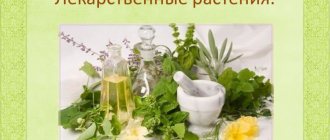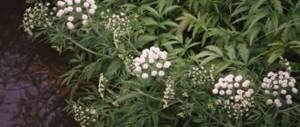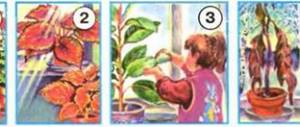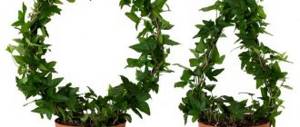Riddles about poisonous berries
When walking through the forest or in the park, relaxing in nature, you need to understand that if a child sees some cute berry, he will certainly want to taste it. No matter how much you talk about such berries, you will not achieve a stronger effect than by playing riddles about poisonous berries. It is especially important to know the riddles about the crow's eye berry, which is quite common and, sadly, attracts children's attention with its resemblance to a blueberry. You can see what it looks like in the picture next to it; you shouldn’t get close to it in the forest, but the riddles about the crow’s eye berries at the bottom of this page will explain everything to your child.
Lily of the valley berries
Lily of the valley is a flower that one cannot help but love; its small bell flowers and berries are so delicate that it seems as if they cannot harm. However, these seemingly harmless berries are poisonous! Not only children, but even adults do not expect such deceit from the lily of the valley. A game of riddles about poisonous berries must include riddles about lily of the valley berries. Forewarned is forearmed.
Presentation “Poisonous Plants”
The presentation “Poisonous Plants” will show children photographs of dangerous poisonous plants and a description of each of them. Each slide is accompanied by professional voice-over. On the slides you will find the following poisonous plants:
Henbane (mad grass) - grows in wastelands and ravines. The fruit resembles a box with a lid. The entire plant is deadly poisonous!
Oleander - The entire plant is deadly poisonous! Do not touch with hands! If you chew one of its leaves and swallow it, the dose of poison will be almost lethal for a person!
Hemlock (vekh) - resembles flowering parsley, but much larger. Deadly poisonous!
Lobel's hellebore and Black hellebore are deadly poisonous!
Hogweed is a tall plant (up to 2 meters in height). The stems and leaves have small bristles, touching which causes severe burns!
Lily of the Valley - All parts of the plant are deadly poisonous. Even a vase of water contains poison. The fruit is a red berry, also poisonous.
Belladonna Belladonna - All parts of the plant are deadly poisonous!
Foxglove - Flowers and leaves are poisonous.
Wolfsbane (fighter) - The entire plant, from roots to pollen, is extremely poisonous, even its smell.
Hemlock - The entire plant is deadly poisonous!
Buttercup (night blindness) - All parts of the plant are very poisonous! Grows in damp meadows and forests.
Celandine - The entire plant is poisonous! Contains milky orange juice that causes burns and poisoning.
Tansy (Wild Rowan) is a poisonous medicinal plant with a characteristic camphor odor.
Snowdrop - You can be poisoned by its bulb, which is mistaken for an onion.
White water lily, yellow capsule - Rhizomes, flowers and seeds contain hazardous substances.
Lilac is a medicinal but poisonous plant.
Nightshade is a medicinal poisonous plant, especially its berries and roots.
Poppy - Unripe green poppy pods are poisonous.
Wormwood - Medicinal poisonous plant
Daffodil - The aroma of a large bouquet of daffodils can cause headaches. The bulb is poisonous.
Mistletoe (Foradendron) - An evergreen parasitic shrub attached to the branches of a host tree. Has the shape of a ball.
Potatoes - It is dangerous to eat potatoes with green sides or sprouted sprouts, as they contain the poison solanine.
The presentation “Poisonous Plants” is intended for the study of poisonous plants using the early development method of Glen Doman. The presentation can be viewed several times a day for no more than 5 minutes. Power Point is required to view the presentation. After downloading the presentation file, open it using this program and press F5 - automatic viewing of the cards will begin in the form of changing slides with sound. If desired, each page of the presentation can be printed on a printer.
You can download the presentation “Poisonous Plants” at the bottom of the page in the attachments.
Notes to educators
Among the wild herbs and shrubs there are poisonous ones that in appearance resemble cultivated edible plants; some attract children with berries or interesting seeds.
Lily of the valley - its berries and rhizomes are poisonous.
There are many poisonous plants in the Apiaceae family: they are similar to parsley, carrots, celery and dill. Children make pipes from the long stems of many plants, put them in their mouths, chew leaves and seeds - this can cause poisoning.
Hemlock (veh poisonous) is a tall plant, its leaves and roots resemble celery, it grows in damp places. All parts of the plant are poisonous, especially the stems and roots.
Hemlock grooved has a stem up to 1.5 m high, hollow, with dark red spots at the base, three-pinnate leaves and fist-shaped petioles, smells unpleasant and contains strong poison. It grows in weedy places along the banks, blooms in June - July.
Dog parsley is similar to cultivated parsley, but the leaves have an unpleasant odor when planted, and the flowers are not yellow-green, like cultivated parsley, but white. The entire plant is poisonous.
Acrid buttercup grows in meadows, damp meadows, ravines, along roads and in vegetable gardens. It blooms from May to autumn with small yellow flowers. The plant is poisonous, especially during the flowering period.
Oak anemone grows in deciduous forests on the edges, clearings, and between bushes. Blooms at the end of April. The stem is straight, thin, the flower has six white or pinkish petals. In damp weather and at night the flower closes. Under the flower there are three dissected leaves arranged in a rosette. The plant is poisonous.
Black henbane grows in vegetable gardens, wastelands, along roads, along river banks. Blooms from late May to September. The flowers are cream, with purple veins, and consist of five petals. The stem is thick and branched. The plant is covered in hairs, smells unpleasant, and is very poisonous.
European swimmer grows in damp meadows, clearings, and under bushes. Blooms in May - June. The yellow sepals fit tightly together and form a ball. The flowers have a faint smell, small insects hide in them in bad weather, and the stem is erect. The plant is poisonous, especially the rhizome.
Marigold marigold (Curosblind) grows in damp meadows, the banks of ponds, lakes and swamps. It blooms in April - May, sometimes also in autumn. The flowers are large, bright yellow. The leaves are wide, heart-shaped. The green part of the plant is poisonous.
The common cockle grows as a weed in grain crops and in fallow fields. The flowers are odorless, violet-red. Its leaves are longer than its petals. Cockle seeds contain toxic substances.
Bittersweet nightshade grows in damp forests, water meadows, and the banks of ponds and rivers. Blooms from late May to September. The flowers are purple. The stem is branched. The fruit is bright red ovoid berries, unripe they are bitter, ripe ones are sweet. The entire plant is poisonous.
Common tansy blooms from June to September with yellow flowers collected in inflorescences. It grows everywhere: in fields, in forests, near roads, less often among bushes. The plant is poisonous.
Wolf's bast is a small (50-100 cm) upright shrub. The stem and branches are covered with brown dots, the flowers are tubular lilac-pink, sitting in groups of 2-3 on leafless branches. The fruit is an oval red drupe, ripens in August. The berries are poisonous.
The marsh whitewing grows in swamps, along the marshy banks of rivers, lakes, and ponds. Blooms from late May to July. The leaves are large, thick, the flowers are collected in an inflorescence-cob, surrounded by a greenish-white leaf. The plant is poisonous.
Larkspur (tall) is a perennial herbaceous plant with a straight stem, height from 60 to 100 cm. Leaves are dissected into 5-7 lobes. The flowers are collected at the top of the stem and are bluish or white. Blooms in June - July. The entire plant is poisonous.
Edible and poisonous plants and fruits
When in extreme situations, to maintain strength it is necessary to use all possible sources of food, including plants. Plants are an excellent source of nutrients that will help you survive.
There are about 300,000 plant species on the planet. About 120,000 of them are edible. About 2,000 edible plants grow in Russia.
In ancient times, people knew very well which plants were edible and which were poisonous. This skill is very important in extreme situations. Plants and fruits contain a lot of nutrients that can help in extreme situations. Some fruits can act as an energy drink, and some can stimulate the body. You can use roots, bulbs, shoots, stems, and fruits for food.
Edible plants
Many parts of plants can be eaten. Rhizomes and tubers. Tubers and roots of plants such as cattail, almond, plantain, forest fern, chicory, sorrel, white and water lily are excellent for consumption as food. You can eat plant shoots: rhubarb, white line, sugar cane, fan palm, bracken.
The leaves of plants such as dandelion, sorrel, nettle, fireweed, and burdock are considered edible. In addition, you can eat the flowers of plants: rose hips, horse sorrel, chamomile, clover, dandelion, acacia, birch, and willow.
Some types of plants can be used as a medicine against scurvy, which is very important for survival. To do this, you need to use plants containing vitamin C. Spruce needles are ideal for this.
Many plants can easily replace leafy vegetables from our regular diet: - Dandelion is a plant that is completely edible. The leaves and roots can be consumed raw. If you grind and roast the root, it can be used as coffee. - Coltsfoot. Leaves and shoots are used for food. - Clover. The stems and leaves can be used in salads. - Nettle. After soaking the leaves in boiling water for 5 minutes, they can be used in salads. They are also used in soups.
Edible fruits
In Russia you can find a large number of shrubs and trees with edible fruits. Blueberry. Grows in most of Russia. Can be found in pine forests, broad-leaved and spruce forests, and swampy places. Blueberry height is 10-50 cm. Lingonberry. Shrub 15-20 cm high. Grows throughout Russia. Prefers spruce and pine forests. The berries ripen in August - September. Blackberry. It is found in almost the entire part of Russia. Grows along river banks and in flood meadows. The bush is covered with thorns. Blueberry. The shrub can reach 1 m. In appearance, blueberries are similar to blueberries. Has a large habitat. Can be found in wetlands, dry areas and mountains. Grows in the European part of Russia, the Far East, the Urals, and the Caucasus. Juniper. A small tree-like shrub. Grows in the forest zone of Russia. Cranberry. Distributed in the forest zone of Russia. Grows in swamps and wetlands. Rowan. Widely distributed throughout Europe. The fruits are rich in vitamins. In addition to the above, sea buckthorn, bird cherry, stone fruit, wild currants, strawberries, and raspberries will help replenish your strength.
Poisonous plants and herbs
There are a considerable number of plants that are considered poisonous and can harm your health and sometimes lead to death. Umbrella plants should be avoided: ash, foxglove, vekh. Blooming umbrellas are especially poisonous and should not be handled with bare hands. Also considered poisonous are: - dope - henbane - buttercups - spurge - bindweed - foxglove - hydrangea - castor bean
Poisonous fruits
Some types of berries should also be avoided: - crow's eye - wolf's bast - red nightshade - lily of the valley - belladonna - swamp whitewing - euonymus - black crow
How to determine which berries are edible
Never eat unfamiliar plants and their fruits. If you find yourself in a hopeless situation, then there are signs that will most likely help you distinguish edible plants from inedible ones: - edible plants usually grow in large clusters; - in most cases, edible berries have one fruit on the stem of the berry branch; — if plants secrete milky sap, then you should not eat it; — most aquatic vegetation is edible; — most fruits of shrubs growing on peat bogs can be eaten; - whether a fruit is edible or not can be recognized by bird droppings; if it contains seeds or peels, then such fruits can be used as food.
Edible plants can be determined experimentally. Rub a small amount of an unknown plant between your fingers. If there is no reaction after 15 minutes, place it on the crook of your elbow. If there is no reaction after 15-20 minutes, place the plant between your lips. If there is no irritation or burning within 15-20 minutes, then take a small part of the plant into your mouth and chew without swallowing. If after 15-20 minutes there is no burning sensation or bitter taste, then swallow it. If after 15-20 minutes there is no nausea, dizziness or other signs of poisoning, then you can use a small amount of the plant for food. If there is no deterioration in health the next day, then such a plant can be used for food.








